
Potager du roi
Encyclopedia
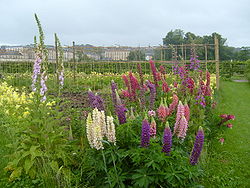
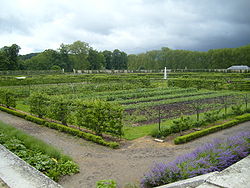
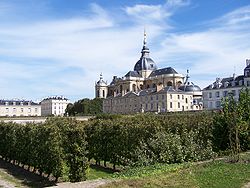
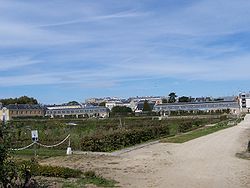

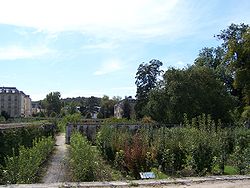
Palace of Versailles
The Palace of Versailles , or simply Versailles, is a royal château in Versailles in the Île-de-France region of France. In French it is the Château de Versailles....
, produced fresh vegetables and fruits for the table of the court of Louis XIV. It was created between 1678 and 1783 by Jean-Baptiste de La Quintinie, the director of the royal fruit and vegetable gardens. Today it is run by the École Nationale Supérieure du Paysage, the high state school in France for the training of landscape architects. It is listed by the French Ministry of Culture as one of the Notable Gardens of France
Notable gardens of France
The Remarkable Gardens of France is intended to be a list and description, by region, of the over two hundred gardens classified as "Jardins remarquables" by the French Ministry of Culture and the Comité des Parcs et Jardins de France...
.
The Potager du roi under Louis XIV
The finished garden looked very much as it looks today. It covered twenty-five acres (nine hectares), with a circular pond and fountain in the center, surrounded by a Grand Carré, a large square made up of sixteen squares of vegetables. Around this was a raised terrace from which the King could watch the gardeners work. A high wall surrounded the Grand Carré, and behind the wall were twenty-nine enclosed gardens, with fruit trees and vegetables. The careful arrangement of the different chambers of the gardens created individual microclimates, which allowed La Quintinie to grow fruits and vegetables out of their usual season.In his Instruction pour les jardins fruitiers et potagers,, on the results obtained by his use of different types of manure, he wrote:
"la chaleur, tant dans la terre que dans l’air ne peut régulièrement venir que des rayons du soleil. J’ose dire pourtant que j’ai été assez heureux pour l’imiter en petit à l’égard de quelques petits fruits : j’en ai fait mûrir cinq et six semaines devant le temps, par exemple des fraises à la fin mars, des précoces, et des pois en avril, des figues en juin, des asperges et des laitues pommées en décembre, janvier..."
"heat, in the earth as well as in the air, can come regularly only from the rays of the sun.
I dare say, however, that I was lucky enough to imitate it a little in regards to some small fruits: I succeeded in making some ripen five or six weeks early, for instance, strawberries at the end of March, early vegetables and peas in April, figs in June, asparagus and lettuces in December, January…"
Since Louis XIV was fond of figs, La Quintinie created a special figuerie. a hollowed-out garden which was sheltered from the elements in winter, which enabled him to grow figs in mid-June. He also had special gardens for melons; three gardens for "herbs, cucumbers and other green leaves;" and gardens reserved for strawberries and cherries. He raised fifty varieties of pears and twenty varieties of apples for the King's table, and sixteen different varieties of lettuce.
During the time of Louis XIV, the potager was an enormous enterprise; it required thirty experienced gardeners to tend to the garden plots, greenhouses, and the twelve thousand trees. Louis XIV brought important visitors, such as the Ambassador of Siam and Doge of Venice, to see the wonders of the garden. He also sent samples of his favorite pear variety, Bon Chrétien, as gifts to other heads of state. The varieties of vegetables served in the garden were an obligatory topic of discussion at the dinner at Versailles. As Madame de Sévigné wrote, "The craze for peas continues; the impatience waiting to eat them, to have eaten them, and the pleasure of eating them are the three subjects our princes have been discussing for the past four days now."
La Quintinie supervised the gardens until his death in 1688. His post was occupied briefly by his colleague, Nicolas Besnard, and then was taken over François Le Normand in 1690. Le Normand's two sons and their descendants ran the potager du Roi for the next ninety years. They created a new garden for raising asparagus
Asparagus
Asparagus officinalis is a spring vegetable, a flowering perennialplant species in the genus Asparagus. It was once classified in the lily family, like its Allium cousins, onions and garlic, but the Liliaceae have been split and the onion-like plants are now in the family Amaryllidaceae and...
, and had to make major reparations to the garden after the extreme cold spell of 1709.
Potager du Roi from Louis XV to the French Revolution
After the death of Louis XIV in 1715, the court departed Versailles, and the budget of the garden was greatly reduced. François II Le Normand made a lawn on the Grand Carré, and experimented with new varieties of plants. A coffee plant had been given to Louis XIV by the Burgemeister of Amsterdam; Le Normand succeeded in growing twelve coffeeCoffee
Coffee is a brewed beverage with a dark,init brooo acidic flavor prepared from the roasted seeds of the coffee plant, colloquially called coffee beans. The beans are found in coffee cherries, which grow on trees cultivated in over 70 countries, primarily in equatorial Latin America, Southeast Asia,...
plants four meters high in the greenhouse of the garden, so Louis XV
Louis XV of France
Louis XV was a Bourbon monarch who ruled as King of France and of Navarre from 1 September 1715 until his death. He succeeded his great-grandfather at the age of five, his first cousin Philippe II, Duke of Orléans, served as Regent of the kingdom until Louis's majority in 1723...
could serve coffee grown in his own garden.
The Court of Louis XV returned to Versailles in 1723, and Louis Le Normand, who became director of the potager du Roi after the death of his brother François, replanted the Grand Carré with herbs and lettuces. He also built a Dutch greenhouse, a low greenhouse with a rounded roof, where, beginning in 1735, he was able to raise pineapples. By the time of the French Revolution
French Revolution
The French Revolution , sometimes distinguished as the 'Great French Revolution' , was a period of radical social and political upheaval in France and Europe. The absolute monarchy that had ruled France for centuries collapsed in three years...
, there were eight hundred pineapple plants in the greenhouses..
Jacques-Louis Le Normand succeeded Louis as the head of the Potager in 1750. He built three new heated greenhouses, and expanded the scientific work of the garden. The garden no longer provided ordinary vegetables and fruits to the Court at Versailles, but only rare and special fruits. Le Normand experimented with rare varieties of plants, such as Euphorbia, jasmine
Jasmine
Jasminum , commonly known as jasmines, is a genus of shrubs and vines in the olive family . It contains around 200 species native to tropical and warm temperate regions of the Old World...
, Latania palms
Latania
Latania commonly known as Latan palm is a genus of flowering plant in the Arecaceae family.It contains the following species:* Latania loddigesii * Latania lontaroides...
, and bananas brought back by French explorers.
Jacques-Louis Le Normand, the last member of the family to direct the potager du Roi, died in 1782, and the garden came under the direction of Alexandre Brown, of English origin, who was the gardener at the royal garden at Choisy
Château de Choisy
The Château de Choisy was a sometime royal French residence in the commune of Choisy-le-Roi in the Val-de-Marne département, not far from Paris...
. Brown made renovations of the garden, reducing the size of the pond in the center, and tearing down the walls between eleven gardens on the north terrace to create five.
In 1785, the Count of Provence, brother of Louis XVI
Louis XVI of France
Louis XVI was a Bourbon monarch who ruled as King of France and Navarre until 1791, and then as King of the French from 1791 to 1792, before being executed in 1793....
and future Louis XVIII
Louis XVIII of France
Louis XVIII , known as "the Unavoidable", was King of France and of Navarre from 1814 to 1824, omitting the Hundred Days in 1815...
, bought for himself and his mistress, Anne de Caumont La Force, the Countess of Balbi, a property adjoining the potager du Roi. He then commissioned his architect, Jean-François-Thérèse Chalgrin, to design and build a country house, (known as Le pavillon de la pièce d'eau des Suisses), and an English garden
English garden
The English garden, also called English landscape park , is a style of Landscape garden which emerged in England in the early 18th century, and spread across Europe, replacing the more formal, symmetrical Garden à la française of the 17th century as the principal gardening style of Europe. The...
, the Parc Balbi on the estate. The new garden had a winding stream, islands, and a belvedere atop an artificial grotto, in the picturesque style of the time. In 1798, the pavillon and garden features were demolished, but traces of the alleys and the lake are still visible.
The potager du Roi from the French Revolution to today
In 1793, during the French Revolution, the garden plots were rented out and the tools and plants, including the eight hundred pineapple plants, were auctioned off. In 1795, the ConventionNational Convention
During the French Revolution, the National Convention or Convention, in France, comprised the constitutional and legislative assembly which sat from 20 September 1792 to 26 October 1795 . It held executive power in France during the first years of the French First Republic...
, the revolutionary government, declared the potager to be a national institute, the tenant farmers were ejected, and the garden became a school and scientific center.
When the monarchy was restored after the fall of Napoleon I
Napoleon I of France
Napoleon Bonaparte was a French military and political leader during the latter stages of the French Revolution.As Napoleon I, he was Emperor of the French from 1804 to 1815...
, much of the garden was overgrown, and many of the trees had died. The new director, Count Lelieur, replanted the orchards and resumed the growing of early vegetables. New greenhouses heated with hot water were installed in 1829, which allowed growing of more exotic tropical fruits and vegetables, and, in 1840, bananas were successfully grown in the Large Greenhouse.
In 1848, the potager became part of the new Institut national agronomique at Versailles, and, the following year, was put under the direction of Auguste Hardy, an agronomist. Hardy directed the school under the Second Republic
French Second Republic
The French Second Republic was the republican government of France between the 1848 Revolution and the coup by Louis-Napoléon Bonaparte which initiated the Second Empire. It officially adopted the motto Liberté, Égalité, Fraternité...
, then under Napoleon III
Napoleon III of France
Louis-Napoléon Bonaparte was the President of the French Second Republic and as Napoleon III, the ruler of the Second French Empire. He was the nephew and heir of Napoleon I, christened as Charles Louis Napoléon Bonaparte...
's French Second Empire, then again under the Third Republic
French Third Republic
The French Third Republic was the republican government of France from 1870, when the Second French Empire collapsed due to the French defeat in the Franco-Prussian War, to 1940, when France was overrun by Nazi Germany during World War II, resulting in the German and Italian occupations of France...
. In 1874, the school became the École nationale d'horticulture (ENH). Under Hardy, the garden grew nine thousand species of vegetables, 309 varieties of apples, 557 varieties of pears, and 94 varieties of peaches..
Hardy died in 1891, and Jules Nanot became director. The school began to teach landscape architecture as well as horticulture; between 1892 and 1905, this course was taught by the famed landscape gardener Édouard André
Édouard André
Édouard François André was a French horticulturalist, landscape designer, as well as a leading landscape architect of the late 19th century, famous for designing city parks and public spaces of Monte Carlo and Montevideo....
, then by André's son, René Édouard André. A separate department of landscape architecture and the art of gardens was begun in 1945.
In 1961, the ENH became an École Supérieure and, in 1976, the École nationale supérieure du paysage (ENSP) was created, and attached to the ENH. In 1995, the ENH moved to Angers
Angers
Angers is the main city in the Maine-et-Loire department in western France about south-west of Paris. Angers is located in the French region known by its pre-revolutionary, provincial name, Anjou, and its inhabitants are called Angevins....
, and the ENSP took responsibility for the potager du Roi.
Today the garden is open to the public. It produces over fifty tons of fruits and thirty tons of vegetables each year, which are sold in Versailles markets and at the school. In addition to teaching, the school regularly re-introduces historic varieties and carries on an extensive program of experimentation. Students come with at least two years' prior university education, and spend a further four years studying at Versailles, including carrying out studies on their own small plots, and planning and executing a project on a particular terrain..
External links
- Le potager du Roi, site de l'École nationale supérieure du paysage (ENSP)
- Le Potager du Roi (vidéo)
- Vue aérienne du Potager sur Google MapsGoogle MapsGoogle Maps is a web mapping service application and technology provided by Google, free , that powers many map-based services, including the Google Maps website, Google Ride Finder, Google Transit, and maps embedded on third-party websites via the Google Maps API...
- http://www.potager-du-roi.fr/visite/media/Dossier_enseignants.pdf

